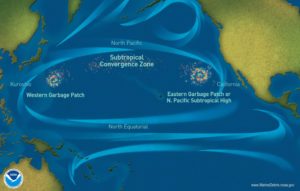By David Bloom
Chatting with Ben Lecomte by phone from his Austin home, it’s easy to forget a few things. One, that he’s French (having lived in the United States longer than in his home country). Two, that he’s 50 (he sounds much younger). And three, that he plans to swim across the Pacific Ocean. All the way. Across. The Pacific Ocean.

Beginning next spring, if everything goes to plan, Lecomte will swim from Tokyo to San Francisco, a 5,500-mile trip expected to take six months. He will swim eight hours a day, then recuperate the rest of each day on The Discoverer, the 67-foot sailboat carrying his support team and supplies.
Along the way, Lecomte’s team will collect and store thousands of samples of ocean water and biometric data about Lecomte, on behalf of a variety of major science organizations researching the condition of the ocean and its impacts on sea life and humans.
To help kick off pre-swim preparations, Lecomte will be featured at the quarterly open house for AltaSea at the Port of Los Angeles. The open house begins at 10 am, Sept. 16, at Berth 58 in the port, at 2456 S. Signal St. in San Pedro, Calif. It is open to the public, but reservations are required. Email RSVP@altasea.org by Sept. 11.
At the open house, Lecomte will be joined by Matthew Mulrennan, director of the Ocean Initiative for Lecomte sponsor the XPRIZE Foundation, and Capt. Charles Moore, founder and research director of Algalita Marine Research and Education. Moore has spent two decades researching the Great Pacific Garbage Patch, a dead zone filled with countless tons of pulverized plastic particles and other flotsam left by humans around the planet.

It is that garbage patch that has motivated Lecomte to take to the ocean again, long after he undertook another record-setting swim two decades ago. In 1998, soon after his father died of cancer, Lecomte became the first person to swim solo across the Atlantic Ocean, a distance of 3,500 miles, to raise awareness about the disease.
Now, he’s once again motivated by a cause affecting those he loves, in this case, rampant ocean pollution and its implications for his children, now 16 and 10.
“Now that I have children, it’s where my motivation is,” Lecomte said. “I’m using what I like to do and creating a platform that maybe can make a little difference. I’m swimming across the ocean to give attention to the problems facing our oceans, so that our kids can maybe have a better future.”
The Discoverer is docked already at AltaSea’s wharf. Lecomte’s support team of eight will spend the fall at AltaSea preparing the boat for the long journey ahead, including an initial five-week sail to Tokyo sometime this winter before the swim begins.
“It’s an amazing thing they’re offering: to have a (dock for our) boat and a space to work, and to work with people who have the same goal in mind,” said Lecomte of the AltaSea resource commitment. “That’s a great asset for us to help us prepare to have a successful expedition.”
Working with Lecomte is a natural extension of AltaSea’s mission, said Director Jenny Krusoe, because it brings together ocean-focused science and education, two parts of the organization’s three-pronged focus that also includes sustainable business incubation.
“We’re proud to support The Longest Swim, providing facilities and other resources for Ben’s team and ship as he prepares to bring worldwide attention to the plastics and other contaminants polluting our oceans,” said Krusoe. “His project is an example of what we’re building here. We’re convening passionate, smart people and organizations dedicated to making our planet better. Ben’s project is a natural fit.”

Lecomte’s planned route will take him across the Great Garbage Patch. Throughout the swim, his team will gather thousands of samples of ocean water, checking temperature, acidity and other factors as part of multiple research grants that will help finance the project.
The path of The Longest Swim also will largely follow the currents that have spread radioactive contaminants from the 2011 Fukushima nuclear plant accident. To help measure the contaminants’s spread, Lecomte will wear a “RadBand” sampling device. Other researchers will use samples from The Longest Swim to investigate the effects of giant phytoplankton on nutrient availability at the ocean’s surface.
Separately, Lecomte’s own body will be subject to significant testing throughout the swim, so scientists can track the impacts of extreme exercise on his “biome,” the ecosphere of bacteria in and on his body.
Researchers also will measure The Longest Swim’s impact on Lecomte’s bones and vision (caused by long-term exposure to the buoyant ocean’s low gravity), as well as possible effects on his heart and emotional state.
Lecomte’s research partners include NASA, the Woods Hole Oceanographic Institution, the Marine Biological Laboratory, Sea Education Association, the University of Texas at Austin, UT Southwestern, the University of Montana, and the University of Chicago.
Project sponsors include the XPRIZE Foundation, TYR, Progea, GoPro, Shotz Natural Energy, LifeProof, Equanimity, DMS Service, and the Exploration Institute. LeComte is continuing to seek sponsors and raise funds for the project. For more information, go to http://thelongestswim.com.
